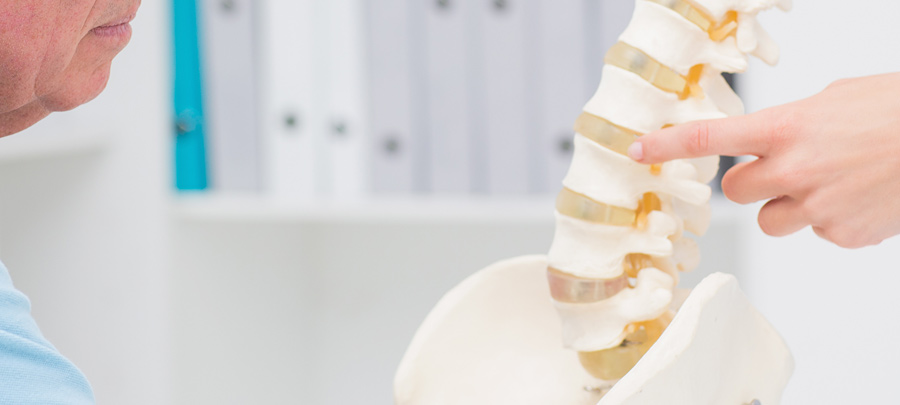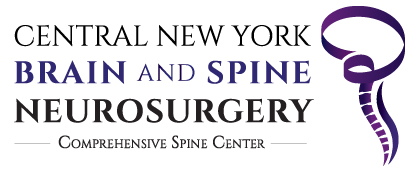Spine Care

Our world class surgical team is very well regarded as specialists in these complex spine surgical conditions and procedures:
Conditions
Sciatica / Disc Herniation
Sciatica refers to symptoms such as pain, numbness, tingling, or weakness that radiate along your sciatic nerve which stretches from your lumbar spine down to your feet.
Spinal Stenosis
Spinal stenosis is defined by the excessive bone and ligament growth of the spinal canal. As a result, the narrowing compresses the spinal cord leading to neck pain, often accompanied with radiating arm pain, numbness or weakness.
Spinal stenosis is a narrowing of the spaces within your spine, which can put pressure on the nerves that travel through the spine. It commonly occurs in the neck and lower back. The condition is often caused by age-related wear and tear.
Symptoms, if they occur, include pain, numbness, muscle weakness, and impaired bladder or bowel control.
Treatment includes medication, physical therapy, and possibly surgery. Watch the video below for more info on spinal stenosis.
Spinal stenosis is defined by the excessive bone and ligament growth of the spinal canal. As a result, the narrowing compresses the spinal cord leading to neck pain, often accompanied with radiating arm pain, numbness or weakness.
Spondylosis (Arthritis)
Spondylosis is a degeneration of the spine that can affect the spine at any level, resulting in pain and discomfort that can grow worse over time. Watch the video below for more info on spondylosis.
Spondylolisthesis
Spondylolisthesis occurs when one of the vertebrae in the spine slips out of position.
Scoliosis
This condition is an abnormal curvature of the spine. It most often develops in early childhood, just before a child reaches puberty. Watch the video below for more info on scoliosis causes, symptoms and treatment.
Scolious Reconstruction
Adolescent and adult scoliosis can often be treated non-operatively through bracing, physical therapy, medication management, and spinal injections. Sometimes, however, the spinal curvature continues to progress or symptoms worsen and surgical intervention is recommended.
Failed Back Surgery Syndrome
Failed back syndrome or post-laminectomy syndrome is a condition characterized by chronic pain following back surgeries.
Vertebral Compression Fractures
This is a collapse of vertebral bone. It can affect one or more vertebrae. Compression fractures typically develop in your mid or lower back. This can change the shape of your spine.
Metastatic Cancer Of The Spine
This form of cancer develops in or near the spinal cord or within the vertebrae. It can spread through multiple levels of the spine. It can lead to a wide range of serious complications.
Radiofrequency Neurotomy of the Lumbar Facets
This procedure uses heat from radio waves to treat painful facet joints in your lower back. It eases pain that isn’t helped by medications or physical therapy.
Procedures
Cervical Fusion
Laminectomy is surgery that creates space by removing the lamina which is a thin piece of bone located at the back of each vertebral body that covers and protects the spinal canal. Also known as decompression surgery, laminectomy enlarges your spinal canal to relieve pressure on the spinal cord or nerves. Laminectomies can be performed on all three sections of the spine – cervical, thoracic, and lumbar.
A minimally invasive cervical laminectomy and fusion is a procedure used to decompress and stabilize the cervical spine. This relieves pain, weakness and numbness caused by narrowing of the spinal canal, a condition called spinal stenosis.
Pain in the thoracic (mid-back) region of the spine can be quite problematic. Mid-back pain from spinal stenosis that does not respond to non-surgical treatment options can limit patients’ abilities to perform their jobs or daily living activities. Therefore a minimally invasive thoracic laminectomy is indicated.
A minimally invasive lumbar laminectomy involves removing a portion of the lamina. A micro-laminectomy may include removing bony overgrowths (ie, osteophytes) and ligament tissue compressing spinal nerves at one or more levels of the spine.
Posterior Cervical Foraminotomy
A Minimally Invasive Posterior Cervical Foraminotomy is a surgical procedure to relieve pain/weakness resulting from a pinched spinal nerve. The surgical procedure is designed to allow for more space for the spinal nerves to pass through reducing spinal nerve root compression.
Typically the patient is under general anesthesia. A small incision about an inch long is made over the treated area. The spine surgeon will use a tubular retractor to access the area, which contributes to keeping the operation minimally invasive. An endoscope is used along with special instruments to remove a small amount of bone to allow access to the nerve root. If the patient’s disc is causing compression of the nerve root, it is carefully lifted and the disc material is removed. This helps take pressure off the nerve root.
A posterior cervical foraminotomy can provide relief of nerve root compression causing pain in the patient with minimal bone removal. The wound is then carefully stitched closed and the patient can go home later that day.
Lumbar Fusion
Spinal fusion is a surgical procedure used to correct problems with the small bones in the spine (vertebrae). It is essentially a “welding” process. The basic idea is to fuse together two or more vertebrae so that they heal into a single, solid bone. This is done to eliminate painful motion or to restore stability to the spine.
Minimally Invasive Lateral Lumbar Fusion
The minimally invasive lateral procedure for spinal fusion is performed through a small incision in your side rather than your back. This protects the muscles in the back from being cut during the surgery. Minimally invasive surgery may have many potential advantages when compared to traditional open spine surgery:
- Smaller incisions and smaller scars
- Less surgical blood loss
- Shorter hospital stay
- Less pain and pain medicine during recovery
The spine surgeons at Central New York Brain and Spine Neurosurgery specialize in performing minimally invasive lateral lumbar fusion procedures.
Anterior Lumbar Interbody Fusion (ALIF)
Description Coming Soon
Transforaminal Lumbar Interbody Fusion (TLIF)
Transforaminal Lumbar Interbody Fusion (TLIF) is a spinal fusion procedure that fuses the front and back section of the spine through a posterior approach. A Transforaminal Interbody Lumbar Fusion treats spinal instability or weakness by permanently uniting bones of the lumbar (lower) spine. The goals of a TLIF are to decompress (remove the pressure from) the spinal cord and/or nerves, re-stabilize the spine, and prevent further movement and degeneration at the joints in question.
Posterior Lumbar Interbody Fusion (PLIF)
A posterior lumbar interbody fusion, called a PLIF, is a surgery designed to stop the motion at the targeted segment of the spine.
A PLIF is done in the lumbar, or lower, spine. Most commonly it is performed on the L4-L5 or L5-S1 segment at the bottom of the lumbar spine.
This surgery may be done to treat lumbar degenerative disc disease, in which a degenerated disc becomes painful. It may also be done for a lumbar spondylolisthesis, in which one vertebra slips forward over the vertebra below it.
A PLIF starts with a three to six-inch long incision in the midline of the back.
Endoscopic Lumbar Discectomy
Endoscopic discectomy, a common type of endoscopic spinal surgery, is a minimally invasive surgical procedure used to remove herniated disc material that is causing pain in the lower back and legs (lumbar), mid back (thoracic), or neck and arms (cervical).
Laminectomy
Laminectomy is surgery that creates space by removing the lamina which is a thin piece of bone located at the back of each vertebral body that covers and protects the spinal canal. Also known as decompression surgery, laminectomy enlarges your spinal canal to relieve pressure on the spinal cord or nerves. Laminectomies can be performed on all three sections of the spine – cervical, thoracic, and lumbar.
A minimally invasive cervical laminectomy and fusion is a procedure used to decompress and stabilize the cervical spine. This relieves pain, weakness and numbness caused by narrowing of the spinal canal, a condition called spinal stenosis.
Pain in the thoracic (mid-back) region of the spine can be quite problematic. Mid-back pain from spinal stenosis that does not respond to non-surgical treatment options can limit patients’ abilities to perform their jobs or daily living activities. Therefore a minimally invasive thoracic laminectomy is indicated.
A minimally invasive lumbar laminectomy involves removing a portion of the lamina. A micro-laminectomy may include removing bony overgrowths (ie, osteophytes) and ligament tissue compressing spinal nerves at one or more levels of the spine.
Kyphoplasty
Kyphoplasty (similar to Vertebroplasty) is a medical spinal procedure in which bone cement is injected through a small hole in the skin into a fractured vertebra with the goal of relieving back pain caused by vertebral compression fractures.
Vertebroplasty
Vertebroplasty is an outpatient procedure for stabilizing compression fractures in the spine. Bone cement is injected into back bones (vertebrae) that have cracked or broken, often because of osteoporosis. The cement hardens, stabilizing the fractures and supporting your spine.
Spinal Fracture Fixation
Open Reduction Internal Fixation (ORIF) is a surgery done to fix broken bones. This is a 2-part surgery. First, the broken bone is reduced or put back into place. Next, an internal fixation device is placed on the bone. This can be done with screws, plates, rods, or pins that are used to hold the broken bone together.
Minimally Invasive Surgery
CNY Brain and Spine Neurosurgery specializes in performing minimally invasive surgery (MISS), which refers to any minimally invasive procedure that targets conditions through the use of small incisions as opposed to traditional surgery, which typically requires a larger incision. For instance, we can safely removing brain & skull base tumors through smaller, more precise openings that minimize collateral damage to surrounding scalp, brain, blood vessels & nerves.
Reconstructive Spinal Deformaties
Complex spinal reconstruction is a term used to describe a number of more complicated surgical procedures that may be needed to address certain injuries and conditions. There are a variety of ways in which a spine may be misshapen, because of scoliosis, kyphosis, Scheuermann’s disease and other problems. In such spinal deformity patients, the spine is curved from side to side, rotated and/or curved forward too much.
There are many ways to reconstruct a curved spine. The type of surgery for spinal reconstruction depends on the degree of the curve, where the curve is located within the spine, patient age, patient general health and other factors.
Non-Surgical Spinal Regenerative Therapy
Before you consider undergoing surgery, be sure to explore the latest alternatives to surgery in the form of regenerative therapy. Regenerative medicine is the new frontier in treating patients with chronic pain and workplace injuries. Regenerative therapy is the process of creating living and functional tissues to repair or replace tissue that are lost due to age, disease, damage, or congenital defects. Alleviate pain with natural treatment options that promote healing and regeneration of damaged tissues. Central New York Brain and Spine Neurosurgery is a leader in central NY for regenerative medicine and stem cell therapy.
Lumbar Epidural Steroid Injection
This injection procedure is performed to relieve low back and radiating leg pain. Steroid medication can reduce the swelling and inflammation caused by spinal conditions.



